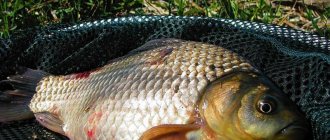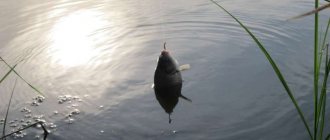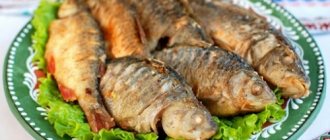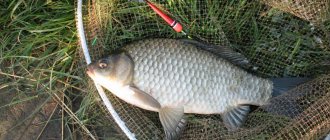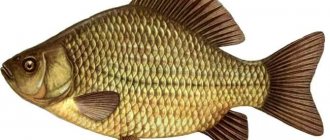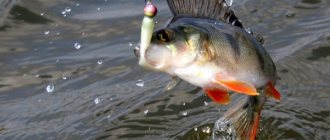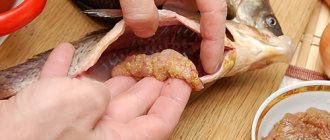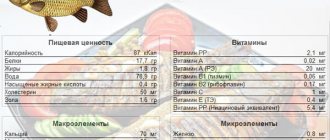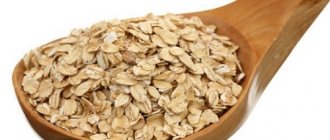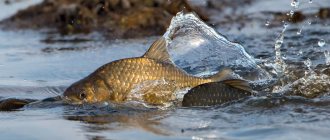Description
Crucian carp is a very common genus of ichthyans; it can be found both in lakes and ponds with stagnant water, and on rivers with moderate currents. Belongs to the class of lechefinned fish, order Cyprinidae, family Cyprinidae. There are different species, since the distribution area is very large. It is not difficult to distinguish it from the rest of the population of the water area; all you need to do is see it in person once.
This is a memorable “personality”; the description is better presented in the form of a table:
| appearance | characteristics |
| body | oblong, round, slightly flattened |
| scales | large, smooth |
| color | from silver to gold with a full range of shades |
| back | thick, with a high fin |
| head | small, with small eyes and mouth |
| teeth | pharyngeal, in one rad |
| fins | there are serrations on the dorsal and anal |
It can reach 60 cm in length and weigh up to 5 kg.
How many years does crucian carp live? The duration depends on many factors, among which the type is of primary importance. The ordinary one has a duration of 12 years, but the silver one is inferior to it in this, no more than 9 years.
Distribution and habitats
Habitats of crucian carp
Initially, crucian carp lived in the Amur River basin and the reservoirs that were adjacent to it. In the second half of the last century, they were distributed artificially in European and Siberian reservoirs. Currently, fish are spreading to India, North America and other regions. At the same time, the number of common crucian carp is rapidly decreasing, as they are being replaced by silver crucian carp.
Crucian carp lives in reservoirs with a soft bottom and stagnant water, which warms up well under the sun. The fish prefers to settle in areas well overgrown with aquatic vegetation. It can be caught in quiet creeks, river channels, ponds and flooded quarries. Crucian carp are undemanding about the oxygen content in water, so they get along well in wetlands, which freeze to the bottom in winter. You can rarely find them in flowing ponds and lakes, but they stay near the bottom of the reservoir.
Diet
This representative of cyprinids is considered an omnivore; there is practically no inedible product for it. However, its preferences vary depending on the stage of development and age:
- the fry, which has just emerged from the egg, uses the contents of the yolk bladder for normal life activities;
- daphnia and blue-green algae to the taste of individuals that continue to develop further;
- the month passes to bloodworms and other small river insect larvae;
- adult individuals have a more varied diet, this includes annelids, small crustaceans, insect larvae, roots of aquatic plants, stems, duckweed, and algae.
Some of the representatives become real gourmets; due to human intervention, boiled porridge, bread crumbs, and dough with butter have become almost the norm for them. It is by using these features that you can catch a large number of this ichthyan. However, crucian carp can often be capricious; on the same day, on the same body of water, it can take completely different baits.
Victoria Leshchenko
I've been working hard in the fishing tackle department for the past six years. I can help you assemble almost any gear.
Ask a Question
The carp representative has a well-developed sense of smell; he hears the bait from afar.
Kinds
Is crucian carp a predator or not? This representative of cyprinids is classified as a peaceful fish species, however, sometimes large individuals can afford to feast on fry of their own kind. But not everyone is capable of this; some species of the genus are completely herbivores.
The genus includes several species, each of which will differ from its relative in appearance. Let's consider the most numerous in more detail.
Golden or common (Carassius carassius)
This is a long-liver among its kind, the maximum individual can live up to 5 years, while in terms of parameters it can reach:
- length 50-60 cm;
- weight up to 6 kg.
Puberty occurs at 3-4 years of age, while the ordinary or golden one has the following distinctive features:
- body flattened laterally, rounded and high;
- the dorsal fin is high, colored brown in the same color as the caudal fin;
- single anal and paired abdominal ones have a reddish tint;
- the scales are large and have a copper tint;
- There is no pigmentation on the belly, but the back is brown.
Its usual habitat is Europe, with its distribution starting from the cold waters of Britain, Norway, Sweden and Switzerland, and ending in Italy, Spain, Macedonia, and Croatia. It is easy to meet crucian carp of this species in Asia; China and Mongolia are native to it, as well as the Asian part of Russia, namely small swampy ponds.
Silver (Carassius gibelio)
Previously, it lived only in the Pacific Ocean; the breeding of crucian carp of this species, which began in the mid-20th century, helped it move considerable distances. Now the silver representative of cyprinids can be found in:
- North America;
- China;
- India;
- Siberia;
- Far East;
- Ukraine;
- Poland;
- Belarus;
- Lithuania;
- Romania;
- Germany;
- Italy;
- Portugal.
Victoria Leshchenko
I've been working hard in the fishing tackle department for the past six years. I can help you assemble almost any gear.
Ask a Question
In many countries, this species has displaced its original owner, the golden crucian, from its usual habitats.
The silver one has more modest dimensions when compared with its gold relative:
- length up to 40 cm;
- weight no more than 4 kg.
Life expectancy is 8-9 years; very rarely there are individuals that manage to live up to 12 years.
The external differences of silver are as follows:
- the body shape is very similar to other representatives of the genus;
- the scales are also large, but have a silver or slightly greenish color;
- the fins are almost transparent, have a pinkish, olive, or grayish tint.
The redfin crucian carp belongs to this species, the silver one was simply able to adapt to the conditions of a single body of water and slightly changed its appearance.
The species perfectly adapts to almost any living conditions, sometimes changing its appearance, this was the reason for choosing it as the basis for a new one, which was bred artificially.
Goldfish (Carassius auratus)
This species was bred artificially, using silver as the basis. There are more than three hundred subspecies, almost all of them are suitable only for breeding in aquariums.
Goldfish will differ in different ways:
- length from 2 cm to 45 cm;
- the body is flattened, ovoid, elongated, spherical;
- the color is very diverse, there are fish of all colors of the rainbow;
- fins are long, short, developing like a butterfly, veil-shaped;
- the eyes are both very small and huge, bulging.
This particular species is called Chinese crucian carp; it is most popular in this country, but other countries of the world also buy it as a decorative decoration for any artificial reservoir.
Japanese (Carassius cuvieri)
Representatives of this species can be found in the waters of Japan and Taiwan. It has no special distinctive features, except that its body is slightly elongated than that of the silver one.
The maximum length of the fish reaches 35-40 cm, but the weight does not exceed 3 kg.
Victoria Leshchenko
I've been working hard in the fishing tackle department for the past six years. I can help you assemble almost any gear.
Ask a Question
Wild representatives are still preserved in nature; you can see and even catch them in Lake Biwa, located on the territory of one of the islands of Japan.
Lately, fishermen have been claiming that a lot of them have appeared in bodies of water with currents. River crucian carp is no different in appearance from individuals from a pond or lake, but its capture is more exciting.
The best baits for crucian carp
The selection of baits for catching the capricious gourmet is impressive, let’s talk about the most effective ones.
Dough
Dough is a favorite bait for crucian carp, which performs excellently all year round. Each fisherman has his own recipe for making dough. It can be different in density, can be made from different flours, can be mixed with milk or water.
Adding flavoring to the dough has a positive effect on the bite. The aroma is selected based on the fishing season. In spring - a little anise, maggot and garlic. In summer, fruity and sweet aromas are preferred. Garlic has a beneficial effect on the bite all year round, but it is especially good as a flavoring agent in the fall.
Semolina
Semolina can be used both as an independent attachment and as part of a mastyrka. Crucian carp bite on it throughout the entire calendar year. It is only important to choose the right flavor. The rules for flavoring are the same as for dough. With the onset of freeze-up, you can do without adding attractants at all.
Semolina is either boiled or cooked in a microwave oven. Small crucian carp hardly react to it, while medium and large individuals treat it very favorably.
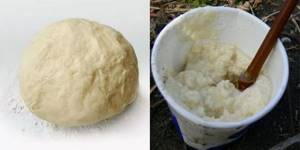
Corn
Corn is an excellent bait for catching trophy crucian carp mainly in the summer months. In the spring, fish bellies are filled with caviar and milk, as a result of which practically no fish are caught using corn. In autumn and winter, bites for corn occur, although slightly less than in summer.
Corn has an attractive natural aroma, so there is no need to flavor this attachment. Corn can be used either canned or soft cooked.
Peas
Peas are very similar in properties to corn. It is also used for catching large and medium-sized crucian carp; there is also no need to add attractants to peas. Steamed peas have a special smell, when they smell it, the crucian carp cannot resist without grabbing the bait.
When fishing with peas, it should be one of the components of the bait mixture.
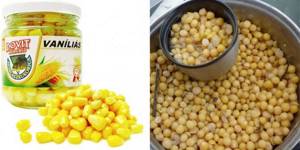
Pearl barley
Pearl barley is used mainly in summer for catching small and medium-sized crucian carp. Large specimens are usually indifferent to pearl barley. It holds the hook perfectly and flavors well.
The necessary attractant is added to the water in which the cereal is cooked. The barley should be slightly undercooked. In this state, it easily fits onto the hook and does not break in half.
Bread
Like all vegetable baits, bread is preferable for catching crucian carp in hot weather. There are several ways to fish for bread. You can simply make a ball out of bread, or you can combine it with cheese.
For greater effect, bread is mixed with attractants. The smell penetrates quickly and lingers. Crucian carp really “respects” such a bait. The dough can be moistened with anise or hemp drops, or even sunflower oil.
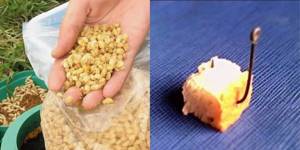
Hercules
In the summer, during the low-biting period, rolled oats steamed in a thermos can help out. Moreover, you can catch both with oatmeal porridge and oatmeal flakes. On flakes, as a rule, the bite is more active. In this case, several pieces are placed on the hook at once, plate after plate.
The larger the rolled oats, the stronger they stay on the hook. In addition to crucian carp, such bait may also be of interest to carp.
Pasta
Slightly undercooked pasta is rightfully considered an excellent summer bait for crucian carp. In the fall, bites on pasta are also possible. They are easy to prepare and keep well during fishing.
Crucian carp bite both on horns and feathers, but stars are the favorite. They are the easiest to put on a hook. When cooking, it is useful to add flavoring and sunflower oil to the water.
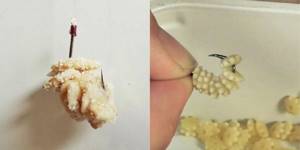
Hominy
A mixture of wheat and corn flour is widely used for catching crucian carp. Welded together, the components form a fairly sticky and viscous mass, and therefore the bait almost does not fly off the hook.
Mamalyga has a wonderful smell and taste, and has a bright color. Effective in summer, with the onset of cold weather it is less effective in fishing for crucian carp. By adding appropriate attractants you can significantly increase the attractiveness of the bait.
Mastyrka
Mastyrka is a mixture of pea porridge and semolina. Perfectly attracts crucian carp in summer. It practically doesn't work in cold water. Mastyrka can also be used as bait.
You can purchase this attachment at any fishing store. But homemade mastyrka has a more pronounced smell, and, therefore, attracts crucian carp better.
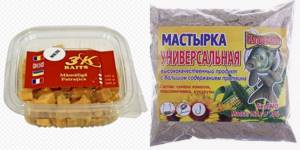
Spawning
Puberty, namely the ability to spawn, occurs in crucian carp at 3-4 years of age. At one time, on average, a female can lay up to 300,000 eggs, and she does not necessarily need to have a male crucian carp nearby for fertilization. But, first things first.
The spawning period begins in the middle zone at the end of May-beginning of June, the main indicator here is the water temperature. Spawning will be possible only at 17-19 degrees Celsius, the process itself occurs in several passes, the intervals of which are never less than 10 days.
The caviar of a representative of cyprinids is yellow and has high levels of adhesiveness; it is the latter indicator that helps it securely attach to underwater vegetation or roots. Further development depends largely on the male, and not necessarily from the same species.
To procreate in the absence of a sexually mature male crucian carp, females can fertilize eggs:
- bream;
- carp;
- carp;
- roach.
Golden crucian milt can also take part in fertilization, although it will not be complete. As a result of gynogenesis, as this process is called, only females from laid eggs will be born.
Interesting! Spawning can continue until August.
What to use to catch crucian carp in summer
In summer, crucian carp is characterized by increased activity. Constantly in search of food. But since in the summer there is a lot of varied food, crucian carp becomes extremely picky.
In cold water, bait is preferred, and when the water warms up, vegetable baits work better.
Using maggots and worms as bait in warm water is not always justified. If immediately after spawning and at the end of summer crucian carp readily grabs them, then in June-July it is better to catch it with plant bait. Dough is considered the best summer bait.
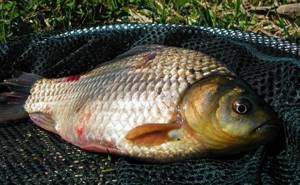
Small and medium-sized crucian carp bite well on semolina, bread, pearl barley, maggots and worms. To catch large crucian carp, it is advisable to hook cooked peas or canned corn. For large crucian carp, a combined bait of several pearl barley grains with a bunch of maggots or worms also works well.
In the summer it is necessary to experiment with attachments and baits, which must be combined with groundbait.
Features of behavior
Crucian carp in the wild grow slower than when artificially bred, the reason for this is nutrition. In the natural environment, the fish will not receive everything it needs in the required quantity; it constantly needs to look for food. When artificially grown, there is more than enough food, often it is simply in abundance specifically so that cyprinids grow faster and gain weight.
How fast does crucian carp grow in a pond? Natural growth looks like this:
- during the first year of life, the fish gains a maximum of 8 g;
- by the end of the second, it already weighs about 50 g;
- at the age of three the individual has a body weight of 100 g.
An adult trophy for a fisherman from a wild reservoir weighs 500 g. And one raised on feeding often reaches 5 kg at the same age.
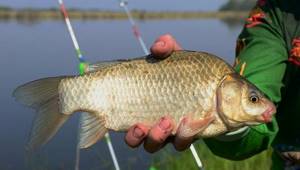
Behavioral features include:
- the possibility of reproduction without a male of the same kind;
- surviving unfavorable conditions in the silt;
- excellent adaptation to almost any living conditions;
- omnivorous.
How long has it taken for crucian carp to grow in a pond? Have you found out what methods can be used to catch it?
Plant baits that crucian carp love
For warm water, plant types are most often used. In summer, crucian carp prefer bread, corn, peas and other ingredients. All of them are easy to prepare and find in the refrigerator. However, some are truly among the best.
Pros:
- They are not exotic (always on the home or store shelf).
- They retain the smell for a long time.
- Easy to prepare.
- A huge number of recipes and mixes.
- Speed of creation.
- Low cost.
White and black bread
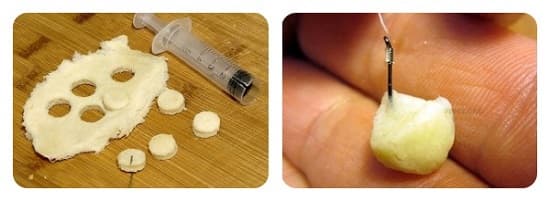
The most accessible and cheapest nozzle. This is especially relevant in hot weather, when crucian carp may not eat anything other than crumbs. Always have a few pieces of black and white bread with you. This way you will be prepared for the finicky fish.
What kind of bread to use:
- Rye (black). It has its own unique and attractive aroma. Less effective on muddy bottoms and currents due to its invisibility.
- Rich white bread (loaf, sweet buns). Visible in any water, contrasts with the dark bottom.
- Bread for sandwiches. Square shape, long shelf life. We maintain our elasticity and freshness for a long time. Few people know, but all this is thanks to the addition of special oil to the composition, which slows down staling. An excellent choice for catching crucian carp.
The hook is attached in one of 2 ways:
- Rolling a pea-sized ball
- Cutting into small slices
To increase the effect, use flavorings: garlic, anise, honey, hemp, dill. Use them if you don’t want to eat plain bread. It will be enough to spray 1-2 times with a spray or dip 1 time into the composition.
Corn and peas
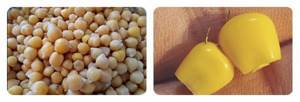
Canned peas and corn are a common and favorite bait. When you open them while fishing, do not throw out the water - it allows you to preserve the alluring smell longer. The attachments have no disadvantages.
They have a lot of advantages:
- Fish like the smell and taste
- Excellent hold on the hook
- Available
- Cheap
Hooks with a short shank are used. It is important to pull the sting out. It happens that there are large crucian carp in the fishing area, but now the small ones are bothering you. Use a bunch of 2-3 peas or corn.
Potato
Boil it in salted water without removing the peel. During cooking, make sure that the potatoes remain undercooked and damp. Check the condition with a toothpick; it should go in with a little effort. Otherwise, having received a completely finished product, it will not stay on the hook. Do not use old, frozen potatoes: they have already lost their smell.
Next, there are 3 options:
- Cut into 1-3 cm cubes and fish on them, without using flavorings.
- Treat the cubes with garlic, anise or honey.
- Additionally, fry them in unrefined oil on each side. This will add additional attractiveness and smell. Store with the lid tightly closed.
We recommend dividing the boiled potatoes into 3 parts and processing each part differently. Thus, from 1 material you get three baits that differ in taste and smell.
Homemade porridge
Homemade porridges are more often used as groundbait rather than bait. It is important not to overcook the grains, otherwise they will absolutely not stay on the hook. Therefore, the bait requires a certain skill and experience; it may not work right away.
- Cook over low heat.
- Any grains can be used.
- Keep on fire until half cooked.
- Turn off and let cool.
- Roll into small balls and place on the hook.
We advise you to carry out all these actions right on the shore. This way you will preserve the aroma, and the excess can be used as bait.
Fishing methods
All and sundry catch crucian carp. It is possible to catch such fish even with the most primitive gear, however, quite a few modern ones have been invented for crucian carp. From early spring to late autumn use:
- donk with a rubber shock absorber (elastic band);
- float tackle;
- crucian carp killer for different numbers of feeders.
The fisherman mounts each of them in his own way, so to speak, for himself. There are many methods and options; in the future we will tell you in more detail about each of them.
It is quite difficult to get this representative of cyprinids from the ice. How does crucian carp winter? It simply buries itself in the silt during severe frosts to a depth of 0.7 m and waits out unfavorable conditions there, including severe drought.
Victoria Leshchenko
I've been working hard in the fishing tackle department for the past six years. I can help you assemble almost any gear.
Ask a Question
It is not worth looking for a relative of carp in the hornwort; the tannin it secretes has a deterrent effect on the entire genus of these fish.
crucian carp
Crucian carp is one of the most famous and widespread fish belonging to the carp family, and fishing for crucian carp can be called a fishing classic.
- Types and their differences
- CROSS, CARP, CARP, WHAT IS THE DIFFERENCE?
- Range of crucian carp (habitat)
- Best time to catch crucian carp
- INTERESTING FACTS ABOUT KARAS:
- Links
- Video
This fish, small in size and weight, is very voracious and picky, which makes catching it convenient and simple. Crucian carp lives in a variety of bodies of water - ponds, lakes and rivers. Experts distinguish two types of crucian carp - golden and silver; they get along well and can interbreed.
The length of an adult crucian carp can reach half a meter. The largest weight is 5 kg.
As a commercial fish, crucian carp has smooth, large scales. The color of which completely depends on the place where the fish lives. In the spring they spawn, with the laying of eggs. Aquatic vegetation is used for this purpose. The habitat of crucian carp is swampy lakes, especially with reeds growing nearby. This type of fish is practically never found in high mountain reservoirs.
Types and their differences
The genus of crucian carp has 5 varieties: 1. GOLDEN CRUCCIAN . (A distinctive feature is the convex edge of the dorsal fin. When examining the head of the fish from the side, its rounded shape is clearly visible, and not pointed, like other species. The habitat is swampy lakes. The color of the scales varies from copper, bronze shades to a golden tint. In winter, crucian carp may fall into a sleepy state, in which it buries itself in the mud. This tactic allows it to survive frosts, even when the lake is completely frozen. They are very tenacious. Cases are described that fish of this species were dug up in a completely dry pond at a depth of 70 cm, and it was alive. They gain their weight depending on feeding conditions, the more food, the faster the fish grows. Crucian carp love to eat aquatic vegetation. They especially like mud, where they can eat organic debris and look for worms. In rivers with a sandy bottom, golden crucian carp grows slower, because there is much less food here. Representatives of this species can live 12 years).
2. SILVER CROSS . (The fish has a pointed head, large scales, the edge of the dorsal fin is not convex, but bent inward. Previously living in Pacific waters and Siberian rivers, silver crucian carp artificially found its way into European reservoirs. Females of this species go to spawn with males of other fish : roach, goldfish, carp, bream. As a result, fertilization by sperm does not occur, but stimulation of the development of eggs is observed. Among the eggs that appear, there will be no males, only females).
3. HYBRID OF SILVER AND GOLDEN CROSS . (Almost never occurs, only in very rare cases).
4. BUFFALO (It is also called a HYBRID or DUSHMAN. Introduced to Russia from America. Bred by the Americans from crucian carp in order to clear grass from various reservoirs and lakes. In Russia, in the city of Goryachy Klyuch, many BUFFALO individuals were bred, which were then distributed throughout the country . Externally, this fish looks like this: the back is brown, the side surface looks dull, and often fishermen cannot at all distinguish a BUFFALO from a silver carp. A distinctive feature of a BUFFALO is the presence of a long fin on the back. The head is similar to the head of a silver carp. This species reproduces as carp The more the water warms up, the more intense spawning occurs).
5. GOLDFISH . (It was bred from goldfish by Chinese specialists. The GOLDFISH breed was artificially obtained in the form of a telescope, comet, lion's head, etc. They are not found in our reservoirs. These fish were bred for aquariums).
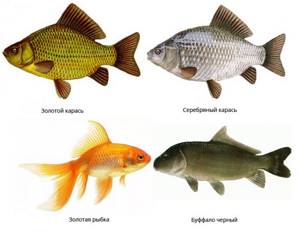
CROSS, CARP, CARP, WHAT IS THE DIFFERENCE?
Carp differs from crucian carp in that it has short antennae, of which there are 2 pairs. If crucian carp more than half a meter is not found, then carp were caught with a length of 1 meter and a weight of 20 kg. Carp lives up to 35 years, and crucian carp lives up to 12 years. Crucian carp has thin, smooth lips, while carp has lips that are more voluminous.
Carp also has antennae, unlike crucian carp. Just below the forehead, carp have a hump, because of which the head is curved. Carp is thick-lipped, and crucian carp has thin lips. In addition, carp have larger scales than crucian carp. On the dorsal fin of the carp there is a prickly spine and a peculiar notch. Crucian carp has a smooth fin. Regarding meat, the following fact can be noted: carp meat is pink in color, with a small number of bones, crucian carp is very bony, its meat is white.
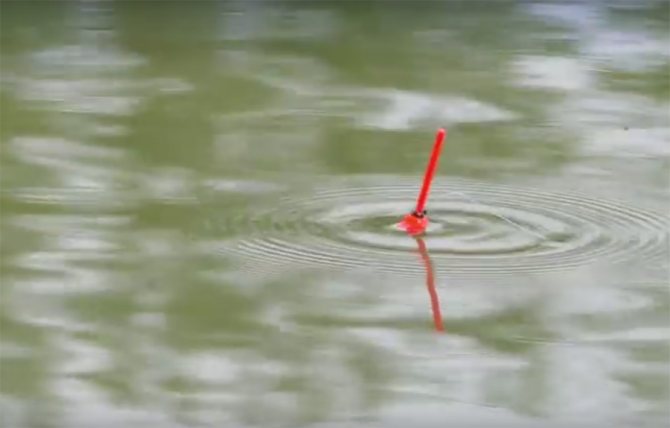
Range of crucian carp (habitat)
Crucian carp is found in a variety of regions, both in our country and in other continents. This small fish is found in the basins of the following rivers:
− Amu Darya, − Dnieper, − Danube, − Volga, − Prut, − Syr Darya.
You can often find crucian carp in the rivers of Siberia, Primorye and the Amur basin. It is not uncommon for crucian carp to be caught in China, Thailand, India and Korea. The fish is also common in Western Europe and North America.
Catching crucian carp is the basis of fishing and catching this fish does not require much skill or special equipment. It’s enough to dig up worms or cook barley – and you’re ready to fish for crucian carp.
Best time to catch crucian carp
Fishing for crucian carp begins in early spring and you should look for fish where the water in the reservoir warms up the fastest. Lakes and ponds that are shallow in depth are best suited for this purpose. In the creeks and shallows, the water heats up faster, and the crucian carp greedily rushes to the bait. In the spring, until spawning, crucian carp is well caught, especially if the winter was long and the fish did not have enough food. During spawning, the crucian bite stops for about a month, after which fishing resumes until winter. In winter, crucian carp is also caught, but with less success than in spring and summer.

Despite the fact that crucian carp bite throughout the day, the best time for fishing is from dawn until about lunchtime, and in the evening - a couple of hours before sunset. Some anglers also catch crucian carp at night, and at night you can catch larger specimens of fish.
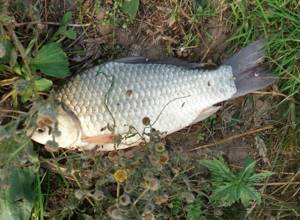
The most convenient places for catching crucian carp When catching small crucian carp - 100-200 grams, you can use bait and the fish itself will come to the place you need. If you want to catch a large specimen, you will have to look for places that can be in different parts of the reservoir - both under the shore and in the middle of the reservoir. The most promising places for trophies are holes and depressions in the bottom, snags and flooded bushes. It is in such shelters that large crucian carp are located, hiding from anglers.
Bait for crucian carp Crucian carp is ready to take any bait, both plant and animal. In spring, animal bait is better suited: - bloodworms, - dung worms, - maggots, - crawlers.
In summer and until mid-autumn, crucian carp bite well on both animal and plant bait. Therefore, it is advisable to take with you the following: - dough, - bread (white or black), - corn, - peas, - semolina, - mastyrka.
Closer to winter, crucian carp again bite better on animal bait and it is better to take worms and maggots with you.
INTERESTING FACTS ABOUT KARAS:
1. Crucians are unpredictable . But not every angler knows that with a strong wind from the north or east, you will not catch a single crucian carp. This fact is due to the fact that light and shadow quickly changes on the surface of the water, and this frightens and alarms the fish. This happens because the clouds move at tremendous speed. With this wind, you can safely leave fishing.
2. What smells do crucian carp like? These are the following aromas: • the smell of garlic; • grated cheese; • unrefined sunflower oil (smell of seeds); • anise drops and valerian; • raspberry extract; • the smell of Corvalol.
Curious crucian carp want to try something that is not in their local pond. For real fishermen, all of the above smells are used to prepare bait for crucian carp.
3. There is a myth about crucian carp , who are drug addicts, that they supposedly like the smell of kerosene. In fact, this is not true. Swimming to the shore at the smell of kerosene, gasoline, or other petroleum products, the crucian carp turns around and swims away in an unknown direction. Other fish swim away with him. The entire fishing trip turns out to be hopelessly ruined.
4. The secret of happy fishing One day, a lucky fisherman was asked why one of his crucian carp bites, but others don’t? What's the secret here? At first he did not want to reveal his secret, but then he admitted that he had developed his own technology for biting crucian carp. It consisted in the fact that, to begin with, he found at his place of residence, or with friends, the most careless housewife who did not like to cook. As a rule, such people have bags of flour on the shelves in the kitchen cabinet, in which worms have long been infested, but there is no time to throw them out while watching TV series. Having received such a bag of worm meal, it is poured entirely into the water half an hour before fishing. The fish swims to the right place, and catching them is a pleasure.
5. The cunning of crucian carp The crucian carp behaves quite cleverly when they try to catch it with a net. It lies on the bottom in holes, then floats away in the opposite direction. This fish knows how to sense a trick. If, when fishing with a fishing rod, the bait seems too heavy to her, she will release it and swim away. This trick helps her maintain numbers. It is no coincidence that in Germany crucian carp are called PEASANT CARP.
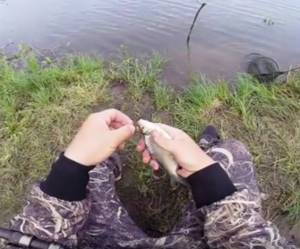
Links
Catching crucian carp with a float rod About crucian carp on WIKIPEDIA A special option for catching crucian carp Crucian carp for 1.5 kg
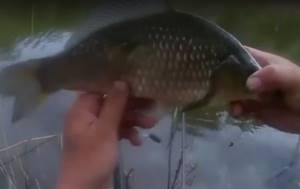
Video
+ Catching large crucian carp
Interesting things about crucian carp
Although our favorite is known to many, it has its own mysteries and secrets, which we will now reveal a little:
- for catching, garlic or anise drops are often added to the bait; these smells will attract even the most sluggish crucian carp if there is no bite;
- artificial breeding began in China, and this happened back in the seventh century AD;
- goldfish are often used by scientists for scientific purposes; they were the first fish to go into space;
- Their sense of smell is excellent; strong-smelling bait can attract the attention of fish located at a considerable distance from it from afar;
- the most sensitive organ is the lateral line; it is this that will tell the crucian carp about food, the location of potential danger, and the approximate distance to a certain object.
Crucian carp are often used for artificial cultivation; many platoons are stocked with this particular genus. Crucian carp grow and develop quickly with proper food; within a couple of years it will be possible to catch the first ones.
The crucian fish is very common throughout the globe. The representative of cyprinids has plenty of species, many are included here, red crucian carp is also there. They are caught using different methods, and which one is most successful is determined by the fisherman himself.
You can ask your question to our author:
General description of fish
Crucian carp has an oblong and slightly rounded body shape. The body is flattened on the sides and covered with smooth scales. Life expectancy depends on the species and living conditions.
Crucian carp in English : crucian, carp, crucian carp, goldfish.
What order, family, class, group of fish does it belong to?
Crucian carp is a representative of the order Cyprinidae and the family Cyprinidae.
What it looks like, color and size
The color of crucian carp depends on the species. It can vary from different shades of silver to gold. The fish has a rather wide back and a high dorsal fin.
The maximum length of an adult is 50−60 cm. Weight depends on the type of crucian carp. The head is small with a small mouth and eyes. A distinctive feature of this kind is the presence of jagged rays in the anal and dorsal fins. The caudal fin is forked.
Internal structure
The biological difference between crucian carp species lies in the number of gill rakers on the gill arch. For example, the silver species has 39–50 stamens, and the golden species has 23–33 stamens. They are needed to purify water.
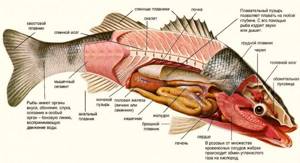
The size of the stamens determines how fine the food can be filtered and sent into the esophagus.
The lateral line is important. It allows the fish to sense almost imperceptible air vibrations that are created by the insects on which it feeds. Crucian carp is able to detect such vibrations at a distance of up to half a meter.
Fish has well-developed taste organs. They are located not only in the mouth, but also on the head. To evaluate the taste of the nozzle, she may not even put it in her mouth.
Heart
The heart is located behind the gill covers and pumps blood throughout the body. Fish have only one circulation, oxygen comes from the water through the gills. In the gills, blood flows through thin capillaries.
Fish intestines
Crucian carp feeds mainly on plant foods, so it has a long intestine. Its size exceeds the body length by 9−13 times. For example, in an omnivorous carp, the intestine is only 2-3 times longer than the body.
How many chromosomes does he have
There are several forms of crucian carp. The first is represented by females and males, the second - only females. Outwardly, they are no different from each other. The difference lies in the number of chromosomes, which can only be determined using a genetic method.
The bisexual form has 100 chromosomes, and the unisexual form has about 156 pieces.
Fish scales
The scales are quite large and smooth. Due to the fact that it does not adhere tightly to the skin, it is quite easy to get rid of it.
What color is caviar
The color of caviar may vary. The shade can vary from dark gray, green to light yellow.
How does crucian carp differ from carp, carp and buffalo?
Crucian carp is a member of the carp family, but at the same time it has a large number of distinctive characteristics.
IMPORTANT. It is quite simple to distinguish crucian carp from carp by appearance - carp have a mustache.
This fish has meatier and thicker lips. The body of the crucian carp is compressed on the sides; the carp has a simply elongated body, covered with light scales. Carp meat has a pinkish-red hue and a minimal amount of bones, while crucian carp is distinguished by white meat and bonyness. Carp is a close relative of crucian carp, but its size can be 2-3 times larger. This fish is distinguished by the presence of two pairs of small whiskers. The meat of carp is not as bony as that of crucian carp. Unlike crucian carp, carp can live up to 35 years.
Buffalo fish have fleshy lips that are covered with small hairs. It is quite large in size. Some individuals can grow up to 20 kg, with a length of 125 cm. Buffalo is not as bony as crucian carp.
